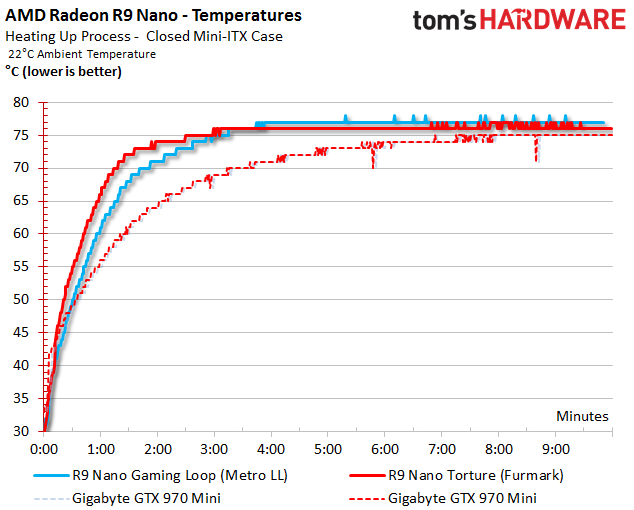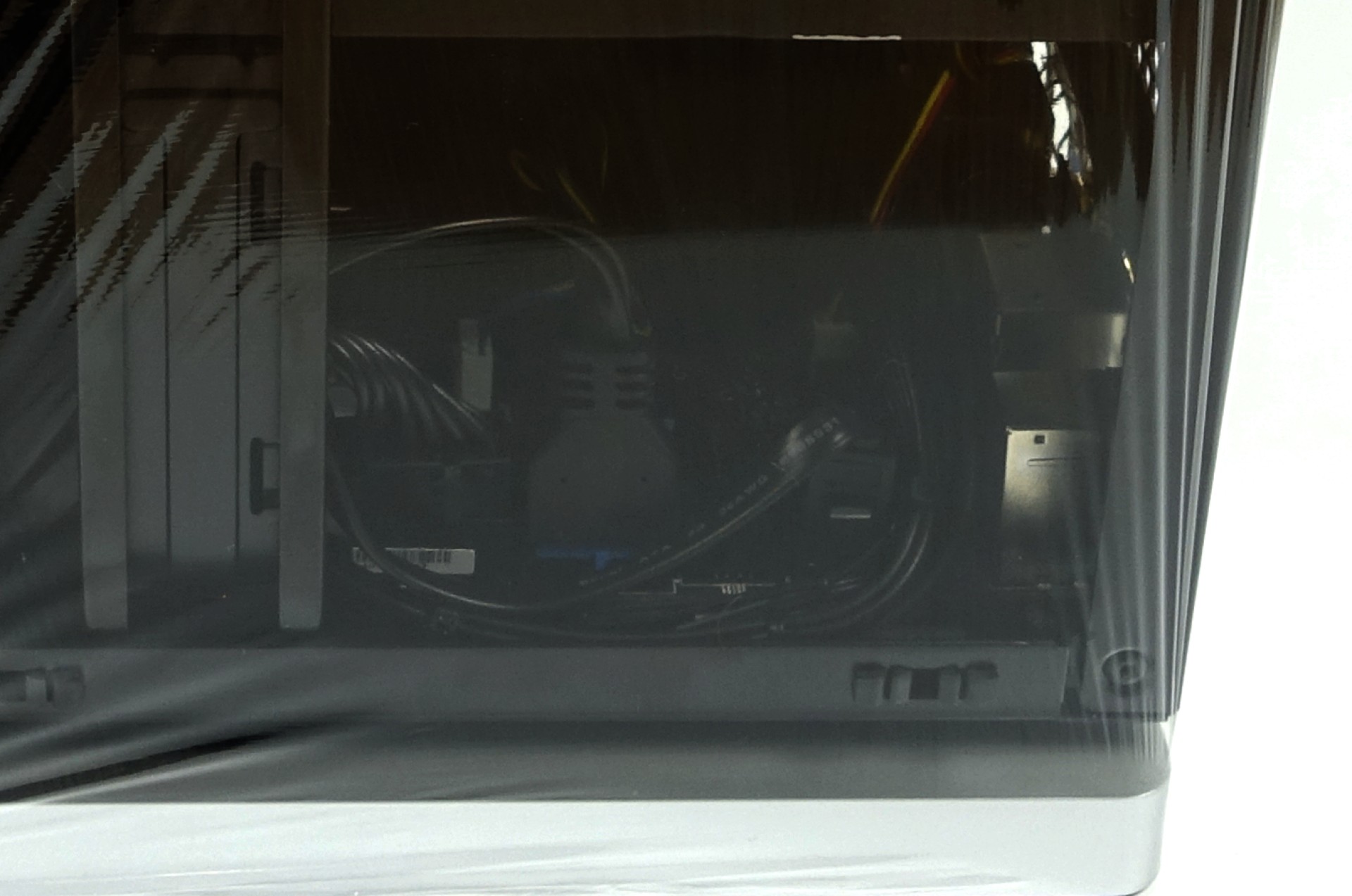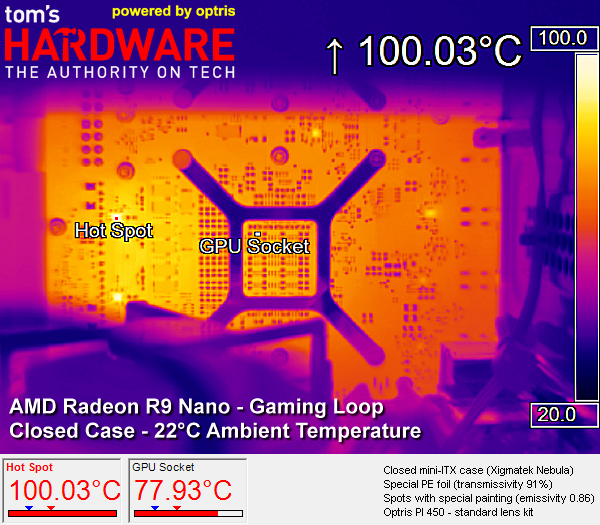AMD Radeon R9 Nano Review
Small, fast and pricey — that’s how AMD wants to establish a whole new product category. But does the Radeon R9 Nano have the performance to back up its price tag?
Results: Frequencies And Temperatures
Actually Reached Clock Frequencies
Those wondering why we’re testing both short graphics cards on our open bench rather than in a mini-ITX case shouldn't worry. Even though the telemetry does take temperature into account for the GPU's frequency and voltage regulation, AMD is emphasizing the power consumption limit a lot more this go-around. In our small PC case, all clock rate throttling would have been due to power consumption, and not the graphics cards’ temperature.
We’re using the X-Trem 4790 by X-Hardware for our mini-ITX system. It’s based on the Nebula PC case by Xigmatek. The reason we chose this particular chassis is its easy-to-remove side cover that snaps in and out of place.
Let’s take a look at the clock rate results in the closed mini-ITX PC case, which, we might add, don’t really differ from those of the open configuration. The temperature curve shows us that the warm-up phase doesn’t change due to the different thermal setup.
It’s baffling that the clock rate drops so much during the stress test, which then results in the Radeon R9 Nano drawing slightly less power than the average during our gaming benchmarks. We also have to note that AMD’s stated “up to 1000MHz” isn’t really a lie, though it’s certainly not what we see during actual gaming either. We’d estimate that our average GPU frequency was more like 850 to 900MHz. Looking at the average, it turns out we were right on the money.
Temperature
A small PC case like this isn’t a fridge, but more of a greenhouse. Both compact graphics cards deal with this fact really well, though. The reason that the temperatures are comparable, even though the Radeon R9 Nano draws more power than the GTX 970 Mini (OC), is that the former pushes more air out of the back of the card via its slot cover. It’s not like 180W is an insurmountable number either, allowing both boards to operate in the small enclosed space without any thermal throttling.
Topping out at 77 degrees Celsius in a tiny closed PC case during a harsh gaming loop is great. Even larger graphics cards with more fans installed in big enclosures do well to achieve those thermal results.
Infrared Measurement in the Closed PC Case
But let’s get back to our PC case and an accompanying DIY project. Perhaps you're wondering how we managed to squeeze a huge infrared camera like the Optris PI450 into a chassis so small that most graphics cards won't fit in it. Simply, we’re taking advantage of the case’s modular design and removing its right side cover. We then borrow a product development procedure. Openings are closed with a special IR-penetrable foil, allowing IR cameras to “see” though them. This sounds simpler than it actually is, since you first need to know the foils’ transmittance (how easily waves of the desired frequency spectrum pass through it).
Get Tom's Hardware's best news and in-depth reviews, straight to your inbox.
We’re using a thin industrial foil with known transmittance for this. It sticks to the PC case without needing any glue. So, airflow and temperatures are identical to a closed case.
In addition, we used a transparent lacquer so that we could use every measurement point’s exact emissivity and transmittance in our software. The end result of all of our efforts can be seen in the following pictures from inside the tiny PC case.
The Radeon R9 Nano has a unique feature: its VRM’s pins don’t stick out of the back of the PCA. This means they can’t be used for temperature measurements. Some of the smaller chips, such as the 5230 RCA, take over this duty by providing a nice strong glow, though.
Our results aren't as dire as they might appear. The board remains under 95 degrees Celsius even after an hour of continuous load. This is quite a feat in today’s graphics card landscape, especially in a closed mini-ITX PC case.
The reason for this great performance can be found in the form of the voltage regulator’s dedicated cooler, which consists of a thick heat pipe and a cooling body with fins. Even during our stress test, things stayed (relatively) cool, with the temperatures, just like the power consumption, slightly lower than our gaming workloads.
So how about the competition? Even though the Gigabyte GTX 970 Mini is meant as a low-cost option for SIs, it does really well when it comes to temperatures. Since it doesn’t employ HBM, we observe the expected hot spots: VRM, memory and GPU.
These results are exemplary as well, especially considering the case's limited space. During the stress test, temperatures increase just slightly.
Overall, the Radeon R9 Nano’s cooling solution is very well designed and executed. It’s sufficient to keep the card cool in a small PC case, as long as there’s at least a little bit of airflow.
| Ambient Temperature22 °C | Closed Case,Gaming Loop | Closed Case,Stress Test | VRMMaximum |
|---|---|---|---|
| AMD Radeon R9 Nano | 76 to 77 °C | 75 to 76 °C | 89 °C (Probe) |
| Gigabyte GTX 970 Mini | 73 to 74 °C | 74 °C | 95 °C (IR) |
Current page: Results: Frequencies And Temperatures
Prev Page Results: Power Consumption And Efficiency Next Page Results: Fan RPM And Noise
Igor Wallossek wrote a wide variety of hardware articles for Tom's Hardware, with a strong focus on technical analysis and in-depth reviews. His contributions have spanned a broad spectrum of PC components, including GPUs, CPUs, workstations, and PC builds. His insightful articles provide readers with detailed knowledge to make informed decisions in the ever-evolving tech landscape
-
Eximo Looks like the table had a hiccup. GTX970 (OC) is showing a lot of the numbers from the R9-390X, and maybe a few numbers from the 980 column.Reply -
-Fran- It is a nice card and I agree, but... It's not USD $650 nice.Reply
This card is a very tough sell for AMD, specially since ITX cases that can house current long cards are not hard to find or weird enough to make short cards a thing.
It's nice to see it's up there with the GTX970 in terms of efficiency, since HTPCs need that to be viable and the card has no apparent shortcomings from what I could read here.
All in all, it needs to drop a bit in price. It's not "650 nice", but making it "~500 nice" sounds way better. Specially when the 970 mini is at 400.
Cheers! -
sna no HDMI2.0 in itx small system near the 4k TV is unforgivable AMD , what were you thinking?Reply -
sna Reply16605176 said:It is a nice card and I agree, but... It's not USD $650 nice.
This card is a very tough sell for AMD, specially since ITX cases that can house current long cards are not hard to find or weird enough to make short cards a thing.
It's nice to see it's up there with the GTX970 in terms of efficiency, since HTPCs need that to be viable and the card has no apparent shortcomings from what I could read here.
All in all, it needs to drop a bit in price. It's not "650 nice", but making it "~500 nice" sounds way better. Specially when the 970 mini is at 400.
Cheers!
well this card is for the smallest case ... not the easy to find huge long itx case.
I personaly find long itx cases useless ... they are very near to Matx case in size .. and people will pick up MATX ovet ITX any time if the size is the same.
BUT for 170mm long card ? this is a winner.
the only thing killing this product is the lack of HDMI2.0 which is very important for itx .. ITX are the console like PC near the tv.
-
heffeque Replyno HDMI2.0 in itx small system near the 4k TV is unforgivable AMD , what were you thinking?
I guess that they were thinking about DisplayPort? -
Nossy I'd go with the 950 GTX for a mini ITX build for a 1080pgaming/4k video HTPC.Reply
For a $650 bucks video card. I'd go with a 980TI and use a Raven RVZ01 if I want an ITX build with performance.







